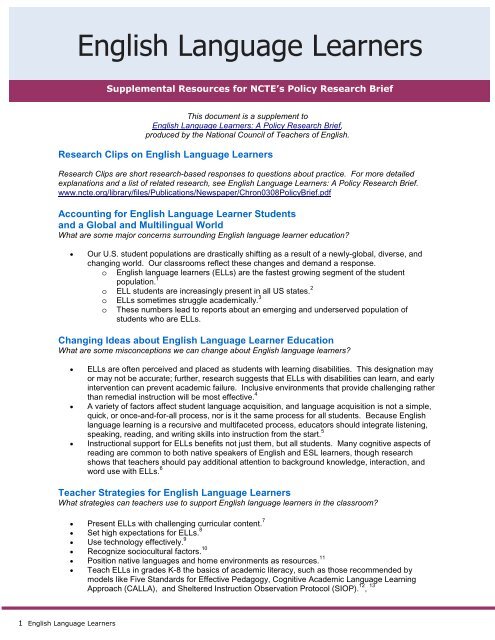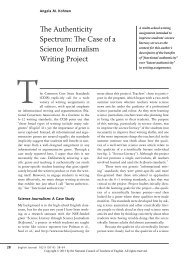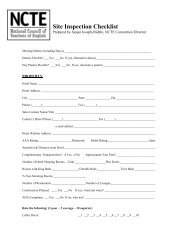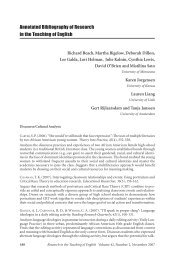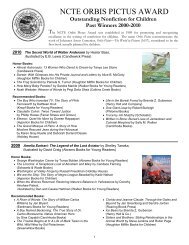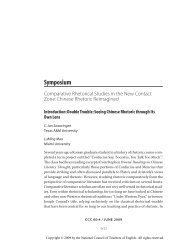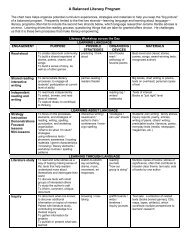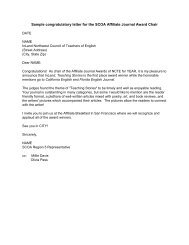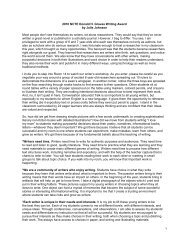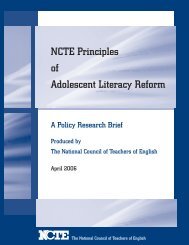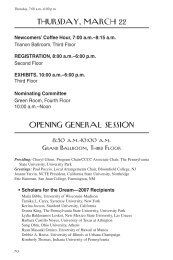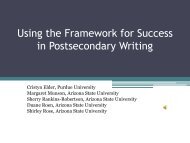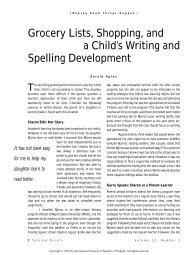English Language Learners - National Council of Teachers of English
English Language Learners - National Council of Teachers of English
English Language Learners - National Council of Teachers of English
You also want an ePaper? Increase the reach of your titles
YUMPU automatically turns print PDFs into web optimized ePapers that Google loves.
<strong>English</strong> <strong>Language</strong> <strong>Learners</strong>Supplemental Resources for NCTE’s Policy Research BriefThis document is a supplement to<strong>English</strong> <strong>Language</strong> <strong>Learners</strong>: A Policy Research Brief,produced by the <strong>National</strong> <strong>Council</strong> <strong>of</strong> <strong>Teachers</strong> <strong>of</strong> <strong>English</strong>.Research Clips on <strong>English</strong> <strong>Language</strong> <strong>Learners</strong>Research Clips are short research-based responses to questions about practice. For more detailedexplanations and a list <strong>of</strong> related research, see <strong>English</strong> <strong>Language</strong> <strong>Learners</strong>: A Policy Research Brief.www.ncte.org/library/files/Publications/Newspaper/Chron0308PolicyBrief.pdfAccounting for <strong>English</strong> <strong>Language</strong> Learner Studentsand a Global and Multilingual WorldWhat are some major concerns surrounding <strong>English</strong> language learner education?Our U.S. student populations are drastically shifting as a result <strong>of</strong> a newly-global, diverse, andchanging world. Our classrooms reflect these changes and demand a response.o <strong>English</strong> language learners (ELLs) are the fastest growing segment <strong>of</strong> the studentpopulation. 1o ELL students are increasingly present in all US states. 2o ELLs sometimes struggle academically. 3o These numbers lead to reports about an emerging and underserved population <strong>of</strong>students who are ELLs.Changing Ideas about <strong>English</strong> <strong>Language</strong> Learner EducationWhat are some misconceptions we can change about <strong>English</strong> language learners?ELLs are <strong>of</strong>ten perceived and placed as students with learning disabilities. This designation mayor may not be accurate; further, research suggests that ELLs with disabilities can learn, and earlyintervention can prevent academic failure. Inclusive environments that provide challenging ratherthan remedial instruction will be most effective. 4A variety <strong>of</strong> factors affect student language acquisition, and language acquisition is not a simple,quick, or once-and-for-all process, nor is it the same process for all students. Because <strong>English</strong>language learning is a recursive and multifaceted process, educators should integrate listening,speaking, reading, and writing skills into instruction from the start. 5Instructional support for ELLs benefits not just them, but all students. Many cognitive aspects <strong>of</strong>reading are common to both native speakers <strong>of</strong> <strong>English</strong> and ESL learners, though researchshows that teachers should pay additional attention to background knowledge, interaction, andword use with ELLs. 6Teacher Strategies for <strong>English</strong> <strong>Language</strong> <strong>Learners</strong>What strategies can teachers use to support <strong>English</strong> language learners in the classroom? Present ELLs with challenging curricular content. 7 Set high expectations for ELLs. 8 Use technology effectively. 9 Recognize sociocultural factors. 10 Position native languages and home environments as resources. 11 Teach ELLs in grades K-8 the basics <strong>of</strong> academic literacy, such as those recommended bymodels like Five Standards for Effective Pedagogy, Cognitive Academic <strong>Language</strong> LearningApproach (CALLA), and Sheltered Instruction Observation Protocol (SIOP). 12 , 131 <strong>English</strong> <strong>Language</strong> <strong>Learners</strong>
13 Fránquiz, M.E. & Reyes, M.L. (1998). Creating inclusive learning communities through <strong>English</strong>language arts: From chanclas to canicas. <strong>Language</strong> Arts 75(3): 211-220.Gonzalez N.E., Moll, L.C., Amanti, C. (Eds.) (2005). Funds <strong>of</strong> knowledge: Theorizing practices inhouseholds and classrooms. Mahwah, NJ: Erlbaum.14 McCarthey, S.J., Garcia, G.E., Lopez-Velasquex, A.M., & Guo, S.H. (2004). Understanding contexts for<strong>English</strong> language learners. Research in the Teaching <strong>of</strong> <strong>English</strong> 38(4): 351-394.15 CCCC Statement on Second-<strong>Language</strong> Writing and Writers (2001). College Composition andCommunication 52(4): 669-674.4 <strong>English</strong> <strong>Language</strong> <strong>Learners</strong>


